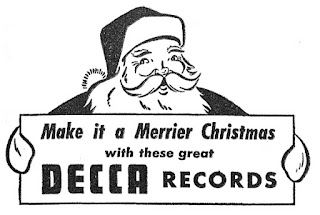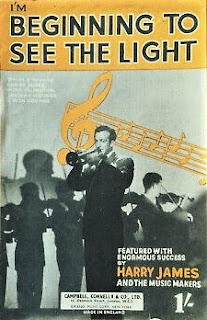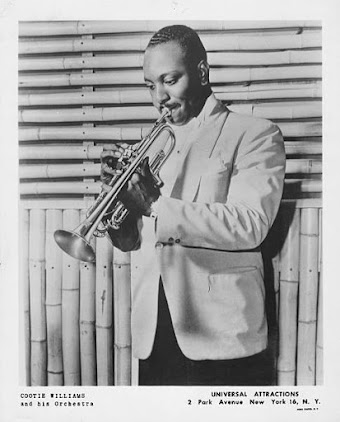 |
| Whoever "Clarence" was, he was a lucky guy! |
Tuesday, June 29, 2021
Jingle Bells - Part 6 - Two from Decca!
Sunday, June 27, 2021
"Jingle Bells" - Part 5 - In the Miller Mood!
We enter the 1940s with another version of "Jingle Bells" that I think merits a more in depth look...
 |
| Paula Kelly surrounded by Modernaires Bill Conway, Hal Dickinson (Paula's future husband), Chuck Goldstein and Ralph Brewster in 1941. |
 |
| Billy May plays his trumpet while Glenn Miller plays with his trombone. |
 |
| Ernie Caceres (left) on baritone sax and Tex Beneke on tenor in "Sun Valley Serendae" (1941) |
Friday, June 25, 2021
"Jingle Bells" - Part 4 - Late 1930s!
We continue along with our survey of "Jingle Bells" recordings with a handful from the latter half of the 1930s.
Always cool to hear Nat "King" Cole with his trio (Nat on piano with guitarist Oscar Moore and bassist Wesley Prince at that point) and this is very early in his stellar career, Nat being only 19 at the time!
Naturally, as with anyone nicknamed "Tiny," he was actually a very big guy - literally "America's Biggest Bandleader!"
Wednesday, June 23, 2021
"Jingle Bells" - Part 3 - The King Swings!
As we continue with our "Jingle Bells" review, I think there are some versions that are extra special and deserve a bit of the spotlight to themselves!
The first of such records is this one by Benny Goodman and his Orchestra on Victor Records.
We left off 1935, and we're still in that year, but we seem to musically jump ahead a light year or two with this cut by the King of Swing himself:
That's the stuff! This is one you can just listen to as entertainment without it seeming like a history lesson!
The Goodman band really kicked the Big Band/Swing era into high-gear with records like this.
Trumpet star Bunny Berigan sat in with the band for this session a couple of weeks before he joined the band and he just lights it up!
And although the label credits Fletcher Henderson with the arrangement (and he wrote many brilliant arrangements for BG), "Jingle Bells" was apparently actually arranged by Spud Murphy.
You can read more about this terrific record here.
This side plays as a swing record that just happens to be based on a seasonal song, but was apparently one side of a special holiday release by (RCA) Victor, as the flipside is Tommy Dorsey's version of a relatively new Christmas song:
In addition to being an early version of "Santa Claus is Comin' to Town," which was published the year before, it was also an early recording by Tommy Dorsey leading his own band, as it was recorded just a few months after Tommy split from the Dorsey Brothers Orchestra, which morphed into Jimmy Dorsey and his Orchestra, and formed his own band, mostly by taking over Joe Haymes's group.
Trumpeter/vocalist Cliff Weston (from the Haymes band) sings the first chorus then Edythe Wright takes over with a jazzier interpretation.
TD's band definitely had a strong Dixieland flavor early on.
Back to Benny Goodman, an interesting counterpoint to the commercial recording of "Jingle Bells" is a second recording of the same arrangement made by BG and his band for the Thesaurus transcription service, which provided recordings for radio station use as opposed to retail sales.
The tricky thing is that many bands used pseudonyms for transcription sessions, such as the Rhythm Makers on this version of "Jingle Bells":
No mistaking that's the Goodman band!
Of note is that Pee Wee Erwin has the trumpet solo here, replacing Bunny Berigan. He does a solid job, although nobody could really complete with Bunny!
Also, BG's clarinet solo is not the same as on the record, which shows the arrangement allowed room for improvisation.
The tenor sax solo by Art Rollini sounds much more like the record, however, but I understand that Art wasn't so much an improviser but he could easily read and play any arrangement.
These transcription songs were recorded in one take during marathon sessions, so you can see how well-rehearsed the Goodman band was!
Next we have an interesting bunch of sides from the latter half of the 1930s!
Monday, June 21, 2021
"Jingle Bells" - Part 2
First up is a quick little version by Phil Spitalny from 1931. This was before he started leading the all-girl orchestra for which he was best-known (and as seen in "Here Come the Co-Eds" from 1945!):
This was released on Hit of the Week Records, which were pressed on something called Durium and could be bought for only 15 cents. 1931 being the depths of the Depression, it was a good deal to get a couple of well-performed songs for that price.
Also from 1931 is this "regular" record by Joe Gumin and his Orchestra:
I don't know too much about Joe Gumin but I understand he was popular in the Midwest back in the day.
This version is interesting in that has choruses sung in different languages. Except for the Pig Latin one, I don't know if any are authentic. Probably not the most PC thing ever!
Another territorial band from the era was led by Charles Dornberger. They played in Canada a lot and I believe this record was cut in Montreal:
That's pretty fun, especially the new verse about modes of transportation with the sound effects!
Always bringing the fun were the various recording groups led by ace banjo player Harry Reser, such as the Clicquot Club Eskimos and the Six Jumping Jacks. This one is billed under his own name but still features his regular vocalist Tom Stacks:
That's just a blast! Love the vocals of Tom Stacks!
These preceding records still all kind of have a 1920s feel to me, but things would be changing.
A more early-to-mid 1930s band sound is featured on this version by Ozzie Nelson and his Orchestra with Ozzie sharing vocal duties with Harriet Hilliard, also from 1934:
This was actually recorded a year before Ozzie and Harriet got married!
Big band aficionados know that Ozzie was a popular bandleader and Harriet (Hilliard) a singer/actress before they started their long-running sitcom on radio then TV.
Fascinating is that this version uses the old-school lyrics that go "Oh what joy..." instead of "Oh what fun..." What was up with that?
We go a little bit back to an older sound with this 1935 recording by the American Novelty Orchestra:
There were tons of records recorded by various bands under various pseudonyms such as this one on cheap record labels such as this one. Hard to say which band this was. Maybe Joe Greene, maybe Jack Shilkret (pictured above). "Cheap" refers to the price, not the performances on such records!
We're off to interesting start and next we'll jump head on into the Swing Era!
Saturday, June 19, 2021
"Jingle Bells" - Part 1
I had fun assembling the songs in some of the recent posts, so I thought I'd look in depth at some of the most popular Christmas songs, kind of following the evolution in more or less chronological order.
We start off with perhaps the most famous song ever, "Jingle Bells."
While it's a seasonal song and not specifically a Christmas song, it's become indelibly linked to the holiday season. Just a couple of notes puts you right in the Christmas spirit!
The song was written by James L. Pierpont in 1857 with the original title of "The One Horse Open Sleigh," but has long been known as "Jingle Bells," based on the chorus.
You can read a lot about the origin of the song on the Internet (with plenty of fanciful speculation), but we're concerned with recordings of the song.
There are a ton, so it will take a while!
My aim is not to discuss every version I can find, but ones that are of interest to me for various reasons.
We start off with a couple of recordings of historical interest.
The first recording of "Jingle Bells" that still exists is a cylinder from 1898 by the Edison Male Quartette under the title of "The Sleigh Ride Party":
Pretty fun. Records are such little windows into the past - you can imagine how great it was for people at the time to be able to listen to recorded music in their homes!
That record has a winter vibe, but nothing Christmassy!
Here's another version. It's 27 years later, but the Shannon Quartet is still pretty old-school:
That's pretty fun and a good refence point as a traditional version of the song with all three verses.
Next: We move into the 1930s!
Monday, June 14, 2021
1945 Bonus Song!
We have one more song from 1945 to consider: "I'm Beginning to See the Light."
 |
| Johnny Hodges (at left) takes a solo. |
Popular (For Some Reason) Posts:
-
I do watch a lot baseball movies and other old movies, but I do occasionally view something newer! As a case in point, I watched the new mov...
-
Hello and welcome to Wheezer's Warehouse! My name's Johnny and I have something of an obsession with retro pop culture. Old music, m...
-
I feel like we need another baseball song as well as more Jerry Colonna, so from the Two Birds Department, here's Jerry's 1946 recor...






















































